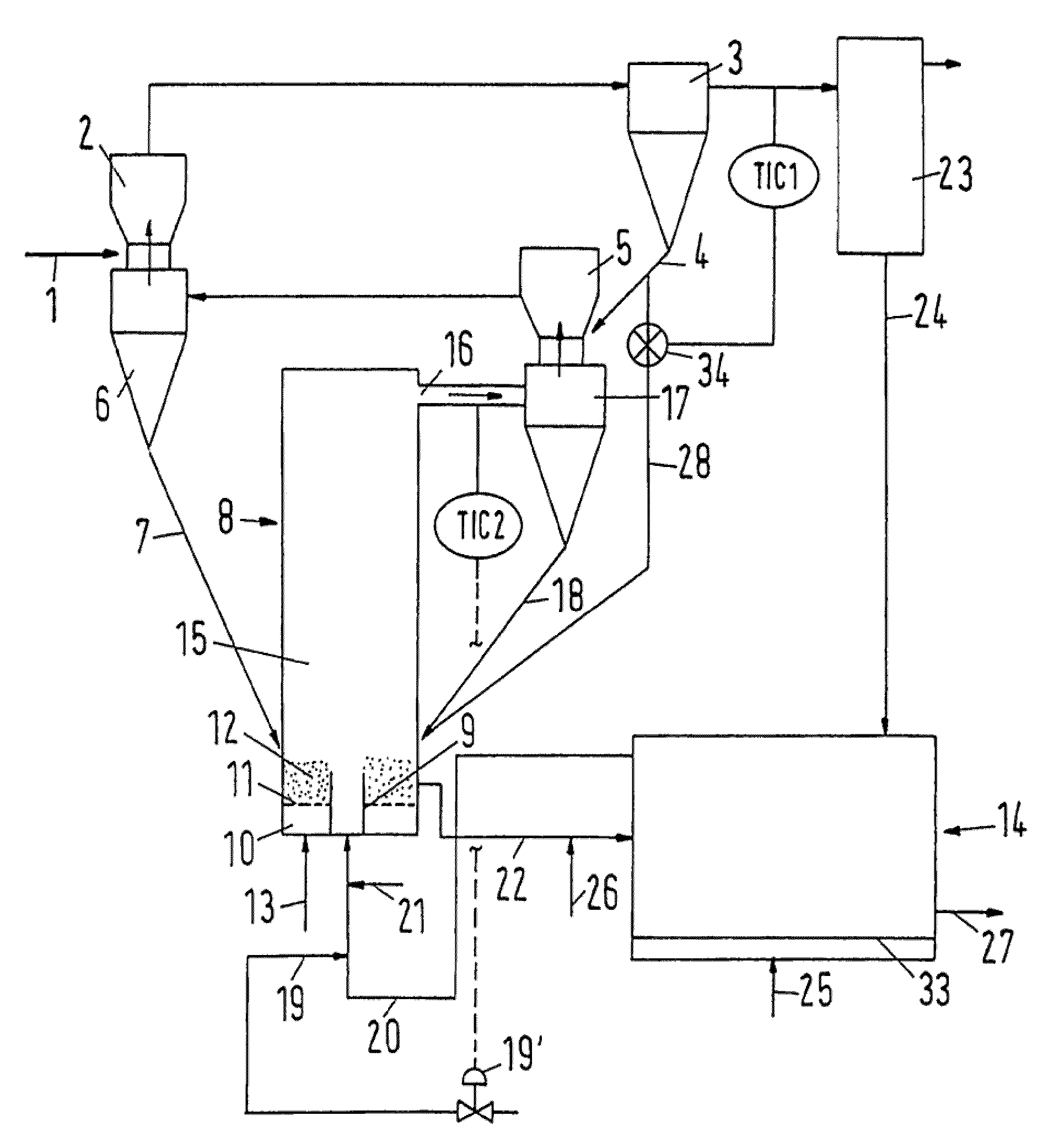Method and plant for the heat treatment of solids containing iron oxide
- Summary
- Abstract
- Description
- Claims
- Application Information
AI Technical Summary
Benefits of technology
Problems solved by technology
Method used
Image
Examples
example 1
Heat Treatment of Lateritic Nickel Ore
[0069]In a plant corresponding to FIG. 1, 220 t / h lateritic nickel ore with a grain size of less than 10 mm, containing
[0070]
1.75 wt-%NiO,31.4 wt-%Fe2O3, 11 wt-%moisture,
[0071]were supplied to the suspension heat exchanger 2 by means of the screw conveyor.
[0072]Upon passage through the first and second preheating stages, the predried nickel ore was introduced into a calcining reactor 8 via conduit 7. Furthermore, 6,200 Nm3 / h natural gas as fuel (through conduit 19), 71,000 Nm3 / h air as combustion gas (through conduit 21) as well as 32,600 Nm3 / h exhaust gas from the reduction reactor (through conduit 20) were supplied to the calcining reactor 8 via the central tube 9, the gas having a temperature of about 800° C. and the following composition:
[0073]
2 vol-%H218 vol-%H2O10 vol-%CO14 vol-%CO2 1 vol-%CH444 vol-%N2.
[0074]In addition, 15,000 Nm3 / h air were supplied to the reactor via conduit 13 as fluidizing gas for forming the annular fluidized bed ...
example 2
Heat Treatment of Chromium-Containing Iron Ore
[0078]In a plant corresponding to FIG. 2, 30 t / h chromium ore containing iron oxide with a moisture content of 5 wt-%, a Cr2O3 content of 53 wt-% and a grain size of not more than 6 mm were supplied to the reactor 8 through conduit 7.
[0079]To the combustion chamber 29, 4,500 Nm3 / h fuel gas were supplied through conduit 19, 5,800 Nm3 / h air preheated to 450° C. were supplied through conduit 21′, and 4480 Nm3 / h recycle gas likewise preheated to 450° C. were supplied through conduit 32. At the opposite side of the combustion chamber, 13,600 Nm3 / h of hot process gas generated by combustion, which had a temperature of about 1600° C., were withdrawn through conduit 20 and supplied to the reactor via the central tube 9. Furthermore, 7,100 Nm3 / h air were fed into the reactor as fluidizing gas via conduit 13.
[0080]21,300 Nm3 / h exhaust gas with a temperature of 1100° C. were withdrawn from the cyclone 17, cooled to 870° C. in the succeeding heat ex...
example 3
Heat Treatment of Iron Ore
[0081]In a plant corresponding to FIG. 3, 178 t / h moist iron ore (hematite) with a moisture content of 5 wt-%, an Fe2O3 content of 80 wt-%, and a grain size of less than 10 mm were supplied to the suspension heat exchanger 2 via the screw conveyor 1 and dried with exhaust gas from the cyclone 6 and preheated to about 277° C. The exhaust gas from the cyclone 6 had the following composition:
[0082]
46.9 vol-%N2 7.6 vol-%H211.4 vol-%H2O 5.7 vol-%CO28.4 vol-%CO2.
[0083]Subsequently, the solids were separated from the gas phase in the cyclone 3 and transferred to the suspension heat exchanger 5, in which they were further heated to a temperature of 561° C. by contact with hot exhaust gas of about 850° C. from the cyclone 17. Thereupon, the material was passed through the cyclone 6 and conduit 7 into the annular fluidized bed 12 of the reactor 8.
[0084]Via the central tube 9, a mixture of 13,000 Nm3 / h air (conduit 19) and 103,000 Nm3 / h hot exhaust gas of about 1000° ...
PUM
| Property | Measurement | Unit |
|---|---|---|
| Area | aaaaa | aaaaa |
Abstract
Description
Claims
Application Information
 Login to View More
Login to View More - R&D
- Intellectual Property
- Life Sciences
- Materials
- Tech Scout
- Unparalleled Data Quality
- Higher Quality Content
- 60% Fewer Hallucinations
Browse by: Latest US Patents, China's latest patents, Technical Efficacy Thesaurus, Application Domain, Technology Topic, Popular Technical Reports.
© 2025 PatSnap. All rights reserved.Legal|Privacy policy|Modern Slavery Act Transparency Statement|Sitemap|About US| Contact US: help@patsnap.com



